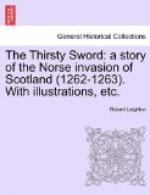Kenric, with his squadron of six galleys, left the little isle of Gigha ere the galleys of Sir Piers de Currie were well out of sight. Through the fierce sound of Islay his good ships sailed as with spreading wings, and the next morning he sighted the isle of Oronsay. Taking the western coast, he crept up to the more northern isle of Colonsay, and stood off a little village that had a castle in its midst. Above the gates of this castle, that was called Dungallan, waved the white falcon banner of the old Norse vikings. On seeing it, Kenric hoisted the banner of the Scottish lion.
Now the position held at this time by both Erland of Jura and Sweyn of Colonsay — vassals both of Hakon of Norway — was shown in the conversation that was the prelude to the murder of the good Earl Hamish of Bute. Of the attitude held by these two island kings towards Scotland, Kenric, however, knew nothing, and though it may be that he was eager enough to meet Earl Sweyn the Silent in mortal combat, yet he did not forget the caution of King Alexander against drawing the sword ere the tongue had done its work. He was loth to show battle, while he was careful enough not to venture ashore unprepared for a warlike reception.
As Kenric was making ready to land he looked towards the shore, and there came down some fourscore of the men of Colonsay. Fair-haired sons of the North they were, all well armed and ready to resist the strangers with a shower of their swift arrows. Then Kenric knew that there was to be no chance of a peaceful parley, and he made no more ado but drew his galleys inshore, and bidding his men crouch down in the shelter of their bulwarks he assailed the islanders with such volleys of well-directed arrows that they soon began to retreat towards their stronghold, leaving several dead and wounded lying upon the beach.
It so chanced that the island was at that time but ill protected, for Earl Sweyn had gone on a roving cruise upon the seas, leaving a weakened garrison to defend his people. By what means the remaining islanders had so promptly prepared themselves for the arrival of the invaders Kenric did not pause to conjecture, but that they had been warned of his coming he could not doubt. Had he by chance caught sight of young Harald of Islay standing apart on the heights the matter had needed no deep questioning. For that young viking had lost no time in crossing over to Colonsay, and though the lord of the island was absent he nevertheless warned the garrison that Kenric of Bute, with a squadron of twelve galleys, was about to make a raid upon their island, and that it behoved them to make speedy preparations to resist him.
His landing being now possible, owing to the retreat of the defenders, Kenric ordered two score of men from each of his ships to take their arms and follow him ashore. With two hundred and forty men-at-arms he then landed. His own retainers of Bute formed in a compact body upon the strand, and led by himself and Duncan Graham they at once marched towards the castle. But John Dornoch’s men of Galloway waited not to give order to their ranks, neither stayed they for the word of command from Kenric, but rushed in hot pursuit of the islanders through the little street of their village.




